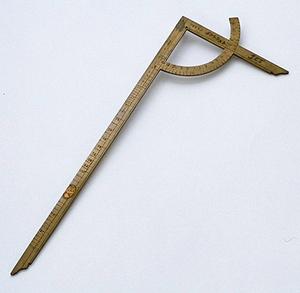This is a 17th century gunner's level and sight:

How is this device used? I know that the plumb bob and angle to the right is for measuring the depression/ elevation of the cannon.
What I do not understand is the function of the extractable ruler to the left. My best guess is that it is a sight for the various pieces' calibers (12 pounder, 24 pounder etc) and that it probably was placed on the breech of the piece, but the exact function of this device eludes me. And how does the second scale "1, 2, 3 etc." fit in?
Can anyone provide me with more precise information?

How is this device used? I know that the plumb bob and angle to the right is for measuring the depression/ elevation of the cannon.
What I do not understand is the function of the extractable ruler to the left. My best guess is that it is a sight for the various pieces' calibers (12 pounder, 24 pounder etc) and that it probably was placed on the breech of the piece, but the exact function of this device eludes me. And how does the second scale "1, 2, 3 etc." fit in?
Can anyone provide me with more precise information?












